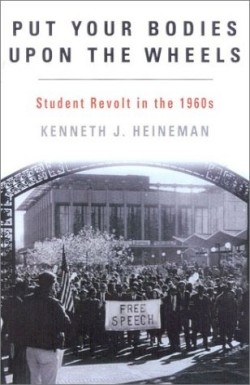Put Your Bodies Upon the Wheels
Student Revolt in the 1960s
The search for the roots and legacies of America’s second Civil War—the 1960s—continues unabated in the many books investigating this tumultuous era. Writers such as Todd Gitlin in The Sixties: Years of Hope, Days of Rage and Terry Anderson in The Movement and the Sixties recall the sixties as a time of social protest responding positively to the social ills brought about by the Vietnam War and racism. Heineman, professor of history at Ohio University and the author of Campus Wars, offers a much less sanguine view of the protest movement, depicting Students for a Democratic Society as a elitist, hedonistic organization best remembered for its many campus bombings that alienated both liberals and conservatives.
Heineman views the New Left as a continuation of the 1930s communist Old Left, molded by distinctive social and economic circumstances of the 1960s: boomers swelling college enrollments, a thriving economy that allowed for new government-funded programs and an over-indulged middle class that was alienated from the working class by wealth and war. The author concludes that the only lesson agreed to by the believers in the “good sixties” and the “bad sixties” is that a society will be irreparably divided when one class is sent to college and the other to war.
Unlike David Burner in his excellent Making Peace with the ‘60s, Heineman does not view the SDS and most other protest movements as once idealistic coalitions that dissolved into anarchy and racial separatism: he identifies these groups as morally and socially corrupt from their inceptions. Sex, drugs, rock and roll, and draft avoidance for the privileged were always their not-so-hidden agendas. He notes that as early as Freedom Summer in 1964 northern students were more notorious for their sexual promiscuity than they were successful at registering southern blacks to vote. Any hope for a biracial civil rights consensus was dashed by the growth of the anti-white, anti-Semitic Students Nonviolent Coordinating Committee and Stokely Carmichael’s expulsion of all whites from the movement. This growing radicalism marginalized the members of the Democratic Party who followed moderates like Martin Luther King and John Lewis.
The author devotes much of the book to campus protest at less elite state universities, such as SUNY Buffalo, Penn State, Kent State, University of Kansas, and the University of Wisconsin, the national center for radicalism. Heineman concludes that following Kent State and the bombing of the Army Math Building at Wisconsin in 1970 Americans despised both the war and the peace movement, which by this time was neither.
This controversial appraisal will not win many supporters among those who fondly remember the sixties as an era of ascendant liberalism and uninhibited social experimentation, but Heineman presents a cogent view of the events that ultimately resulted in a conservative backlash and resurgent Republican Party during the 1980s and 1990s.
Reviewed by
Karl Helicher
Disclosure: This article is not an endorsement, but a review. The publisher of this book provided free copies of the book to have their book reviewed by a professional reviewer. No fee was paid by the publisher for this review. Foreword Reviews only recommends books that we love. Foreword Magazine, Inc. is disclosing this in accordance with the Federal Trade Commission’s 16 CFR, Part 255.

